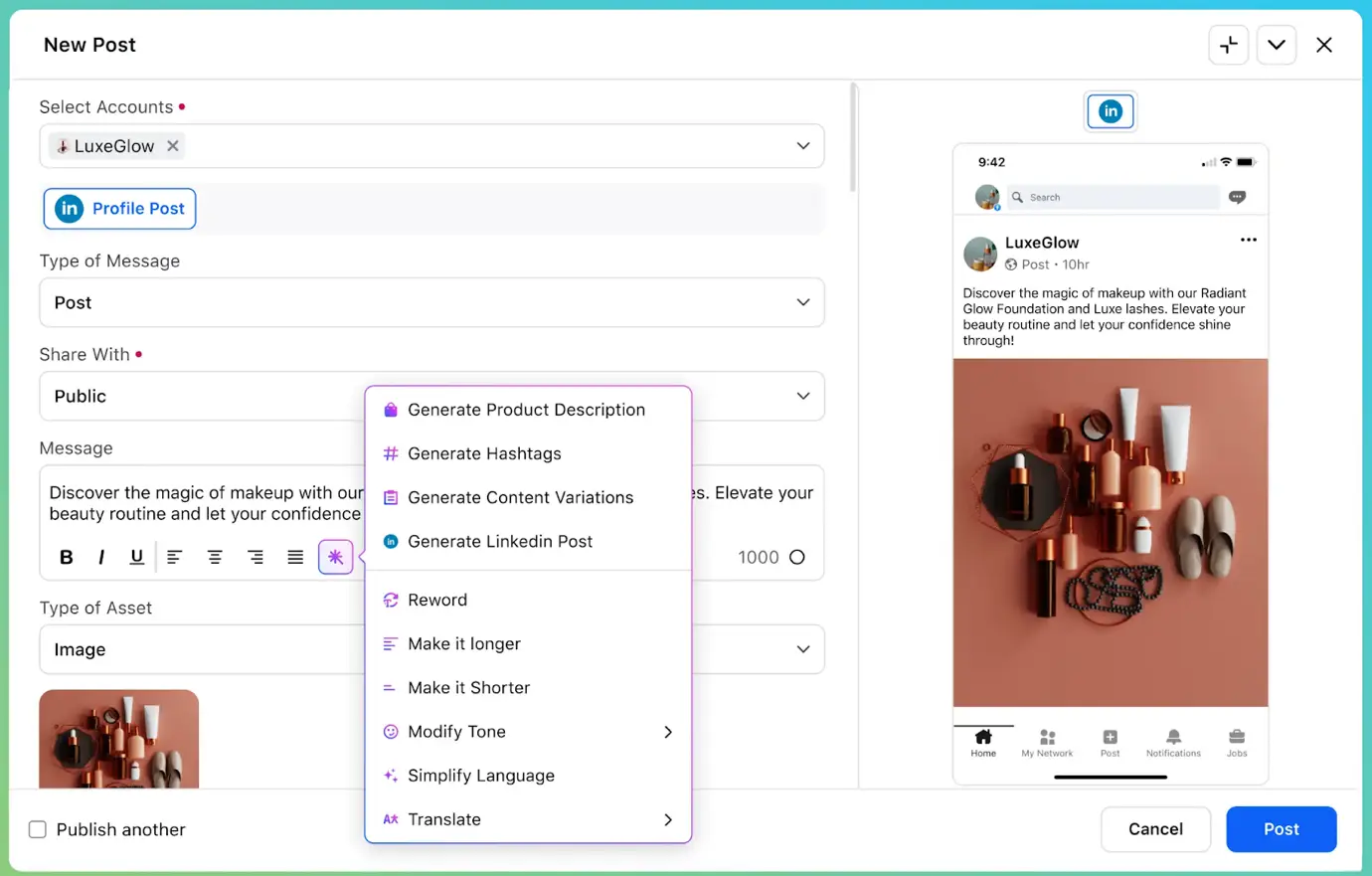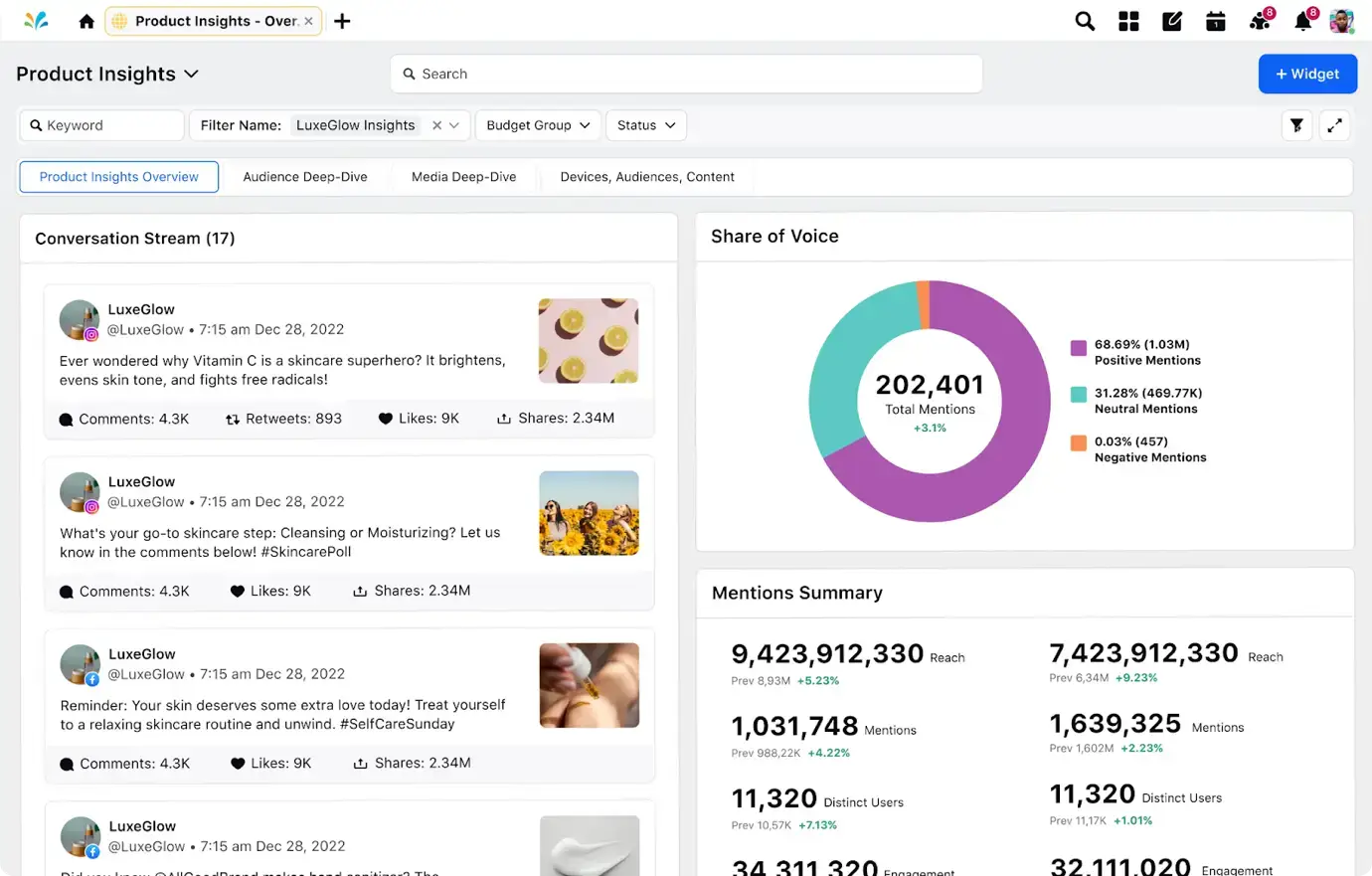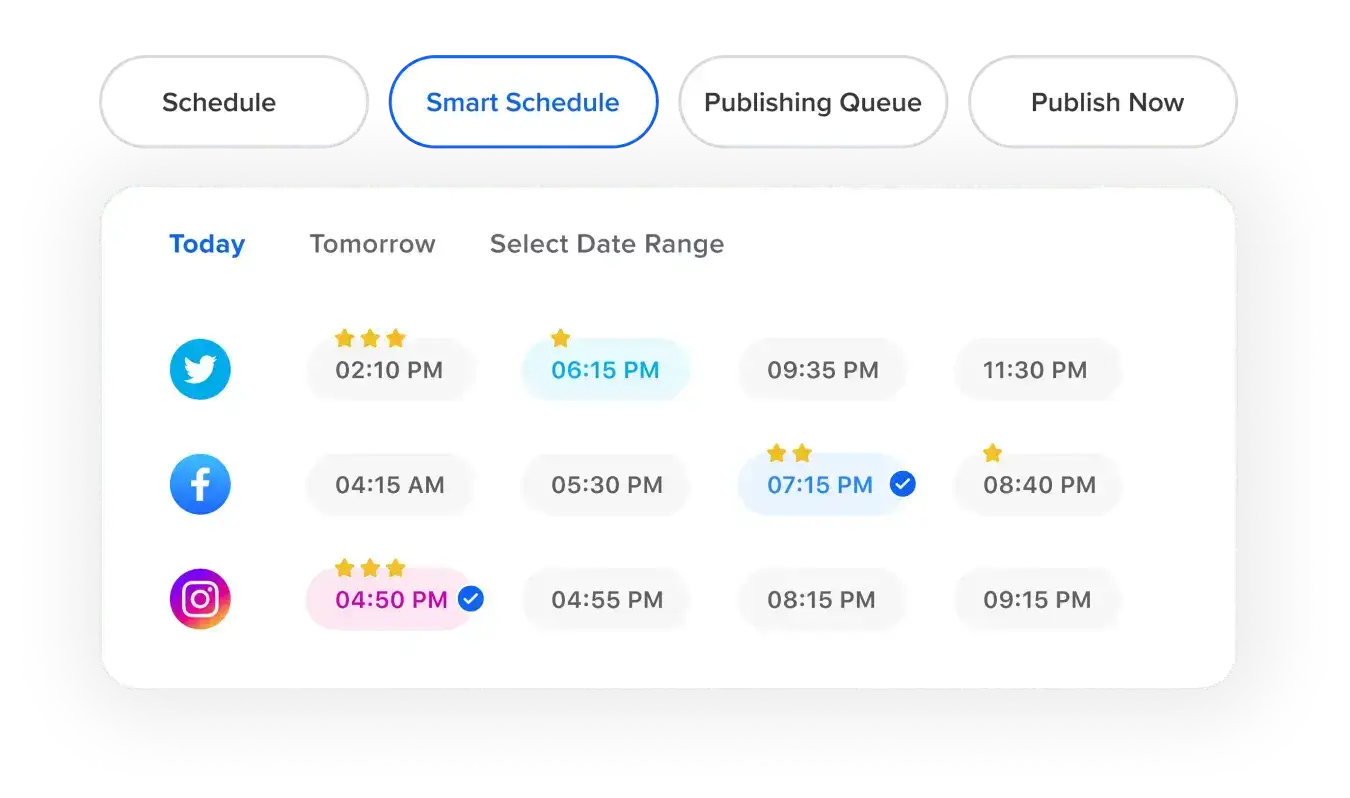The undisputed leader in social media management
For over a decade, the world’s largest enterprises have trusted Sprinklr Social for its in-depth listening, unmatched channel coverage, enterprise-grade configurability and industry-defining AI.

5 Social Media Interactions You Should Track and Improve
Social media interactions power today’s hyper-connected world. Modern consumers actively seek meaningful connections with brands. They want 21st-century brands to offer real-time engagement, personalized experiences and ease of communication.
Recent data reveals that 90% of social media users follow at least one brand on social media. These platforms are assets for brands. They are essential for tracking user sentiment and ensuring your brand is heading in the right direction. Want to know how for yourself?
Well, in this blog we’ll be covering the five types of social media interactions. You will discover six proven strategies to track and improve your social media interactions and the top tools for monitoring interactions. Let’s get started!
What is a social media interaction?
A social media interaction is any form of communication between a brand and social media users. It can be likes, comments, follows, tags or even direct messages.
80% of social media users have purchased a product in response to social media content. This shows how effective social media interaction can drive sales. Such interactions help brands understand the effectiveness of their social media strategy, enhance brand visibility, nurture customer preferences and drive social media conversions.
Difference between engagement and interaction in social media
While social media engagement and interaction are related terms and may sound similar, they are not the same. An interaction refers to a specific user action, such as liking a post or following someone. Engagement refers to the overall involvement and participation of users with the brand. This includes interaction and other metrics, such as the number of saves, downloads and shares. Overall, interactions are specific actions taken by users, while engagement covers a broader spectrum of online activities.
Must Read: How to Measure Social Media Engagement Effectively
Different types of social media interactions
Now that you have a fair idea of what a social media interaction is, let’s get into the specifics by looking at its 5 different types:
1. Reactions
Reactions include the 4 main types of interactions — likes, shares, comments and saves.
Likes: Likes are the key social media interactions to track, with 45% of US consumers saying they frequently like brand-related posts. They are essential for visibility and engagement.
Shares: Social media users can share posts with others or reshare them on their feeds, stories or via private messages. Users share what they like, relate to and find valuable. About 45% of a survey’s respondents reported having shared an opinion piece they agreed with on social media. Sharing amplifies your content’s reach.
Comments: Comments enable people to interact directly with brands. Whether it’s a suggestion, appreciation or even criticism, comments are crucial in social media interactions. They open up new conversations and offer the chance to clarify queries, enhancing your brand’s engagement.
Related Read: How to Respond to Customers on Social Media (+ Examples)
Saves: These are specific interactions where users bookmark or save content to revisit it later. A high number of saves indicate that users see your content as valuable and worth revisiting. Social media algorithms may push such posts to a broader audience, as they are considered engaging and worthwhile.
2. Following
Following is another powerful metric when it comes to social media interactions. Reports reveal that 83% of users follow brands on social media for the latest information. Other reasons include users following brands for interesting content, easy way to contact the company and more, as shown in the graph below. It's much easier for users to be up to date about brands and their content when they’re following the latter.
3. Direct messages
Did you know that 60% of U.S. customers prefer to communicate with brands through text and DMs? Also, 65% are likely to ditch a brand if they are ghosted by a support representative. So, make sure you follow up with customers. Direct messaging includes direct messages, private messages and live chat. Over time, direct messaging has become vital for brands to engage with their audience and vice versa.
4. Reviews
Reviews refer to user feedback about a particular product or service. Almost 95% of customers check online reviews before making a purchase, and 58% say that they’d shell out more moolah for products that have good reviews. Reviews establish brand credibility with users more than any other interaction.
5. Hashtags, tags and mentions
Tags link content to your profile. Mentions directly reference your profile with an “@” symbol. Hashtags are phrases or keywords with a “#” symbol to help users easily discover related content. These interactions increase visibility, engagement and reach. Want to know how you can make your hashtags work for you? Check out our dedicated guide on finding the hashtags that actually work.
Consider Apple. The company uses the hashtag #ShotOniPhone to engage its audience on social media. Currently, the hashtag has over 30 million posts on Instagram, making it one of the most successful campaigns that use User Generated Content or UGC.
Suggested Read: Why Social Mentions Matter for Brands (+ how to use them)
Why are social media interactions important?
A shoppable Instagram live stream can fetch over 40,000 comments, and these are the posts that social media algorithms generally promote because they’re getting more interactions. This indicates the importance of social media interactions, but there are several more reasons why, so let’s uncover them:
- Strengthen customer relationships: Customers feel more connected with a brand that interacts with its audience. Take a look at Adidas, for instance. The brand excels at fostering connections through personalized responses. This approach has helped it in building customer loyalty and trust.
Additional Read: Prevent friction points from impacting customer relationships
2. Increase brand recall: Active engagement boosts brand recall. Take Wendy’s, for example. The brand’s social media team actively interacts with users in a quirky way. Here, Wendy’s humorously replied to a user while engaging in friendly banter with its rival, McDonald’s. The post received more than 500,000 views, boosting brand recall.
3. Support promotional activities: Social media interactions can amplify promotional efforts. Posts and interactions to promote offers can be a great strategy to reach wider audiences. For instance, Sephora uses Instagram to promote new product launches and offers.
4. Reduce customer churn: Customers expect quick responses from brands on social media. The quality of these interactions can improve brand perception, thereby reducing customer churn rate. In fact, brands that don’t respond to customers on social media have a 15% higher churn rate than those that do.
5. Track marketing efforts: Social media interactions can help brands understand the results of their marketing efforts. They can use app-native and third-party tools to analyze each interaction and tweak their strategies accordingly. Here, a social analytics and reporting tool like Sprinklr Insights can go a long way in helping brands uncover deeper insights and make data-driven decisions.
6 strategies to improve your social media interactions
So, you know why social media interactions are crucial, but how do you make the most of them? Well, let’s look at the top 6 strategies that’ll help you ace your social media interactions and build your social media presence:
1. Choose the appropriate platform
Brands must understand the target audience to choose the right platform. For example, LinkedIn is a good choice for a B2B brand, but for an e-commerce company, Instagram and X (previously Twitter) would be better choices. Brands should define their niche audience and choose their platform accordingly.
Things to consider:
- Choose platforms where your target audience is most active to maximize your reach and impact.
- Tailor your content to each platform's strengths to engage users and match their preferences. For instance, if you are a B2B brand, share thought leadership articles on LinkedIn to engage with your industry.
- Use analytics tools to measure interactions and track performance for data-driven improvements and strategies.
Pro Tip 💡: Sprinklr’s AI-powered social media publishing and engagement tool can help your brand create impactful content and analyze performance across 30+ social and messaging channels. It empowers your teams to deliver positive brand experiences across all social touchpoints.

You should avoid:
- Maintaining a presence on every platform. This may dilute your efforts and lead to ineffective engagement.
- Overlooking the unique features and audiences of each platform. This can prevent you from fully capitalizing on what works for these platforms.
2. Create engaging content
The average attention span of social media users is just 8 seconds. Brands can leverage this by creating short, interactive posts. Creating compelling content can also mean staying on top of current trends. For instance, on Father’s Day, Zomato shared a relatable post on Instagram. The content resonated emotionally with the audience, generating 9,000+ likes.
Things to consider:
- Use compelling storytelling to draw your audience's attention and create an emotional connection to make your content memorable and impactful.
- Focus on creating content that fosters interactions like polls, quizzes and questions for more audience participation.
- Keep up with the latest social media trends to ensure your content remains current and relevant. This will help improve engagement.
Pro Tip 💡: Monitor UGC and brand mentions in text, images and videos to detect trends. Track key KPIs to improve customer satisfaction and engagement. Consider leveraging Sprinklr’s social listening tool to understand unstructured data from different channels. The toolkit delivers insights with industry-leading accuracy in sentiment analysis, emotion detection, entity recognition and text classification.

You should avoid:
- Posting content that is too sales-focused or promotional. This can turn off your audience and reduce engagement.
- Creating generic, uninspiring or repetitive content. It will not help you stand out in the highly competitive social media landscape.
3. Optimize content for each platform
While creating platform-specific content is a good practice, you also need to optimize it. Each social media platform has its own algorithms, so what works on one may not work on another.
Things to consider:
- Keep your messaging and tonality aligned with each platform's unique style and audience expectations. For example, short-form videos are popular on TikTok, so use those to connect with younger audiences on the platform.
- Take advantage of each platform’s features, such as Stories, Reels or live streaming, to facilitate interactions.
- Carefully select and optimize hashtags and keywords to improve content discoverability and relevance. For instance, if you are a fast-food brand, use related and niche hashtags like #burgerlove or #pizzatime to promote your post.
- Continuously track and analyze performance metrics to keep learning and evolving.
You should avoid:
- Using a one-size-fits-all approach by posting the same content across platforms. You will need more than this to leverage the benefits of each platform.
- Overlooking platform-specific practices like post timings, frequency and type of content. This may decrease your content reach. For instance, X (formerly Twitter) experiences lower activity levels in the afternoons, so avoiding posting during that time might be better.
4. Schedule content optimally
Posting content when your audience is most active can help brands improve their reach and social media interactions. This also involves analyzing peak times when your target audience is the most active.
Things to consider:
- Schedule posts when your audience is most active to maximize visibility and engagement. For instance, Tuesdays, Wednesdays and Thursdays are usually the best days to post on Instagram.
- If you cater to a global audience, consider global time zones. This will help you reach users at optimal times across regions.
- Use a social media content calendar and plan content ahead of time to ensure consistency and strategic timing.
You should avoid:
- Posting at random times and irregular intervals. This can reduce your brand’s engagement.
- Scheduling too many posts within a short time frame. This may prevent your brand’s message from reaching the right audience.
Must Read: Best Times to Post on Social Media for Better ROI
Pro Tip 💡: Use a tool like Sprinklr’s social media scheduler and publisher to automate posts and post at the right times. With it, you can:
- Create, schedule and manage all your social posts from a centralized platform
- Publish your posts at AI-recommended times for maximum engagement
- Manage all the content for all your go-to social media platforms from a single place

5. Encourage audience participation
Posting content that encourages your audience to take action makes them feel involved with your brand and prompts active engagement with your content. Brands can do this by posting polls and quizzes. They can even host social media contests and giveaways.
Things to do:
- Use direct and engaging calls-to-action (CTA) that encourage your audience to interact actively with your content, such as “Comment below” or “Share your thoughts.”
- Experiment with different forms of content like 360-degree photos and augmented reality to promote audience participation.
- Motivate your audience with rewards or recognition to incentivize engagement and loyalty.
You should avoid:
- Creating lengthy surveys or forms for users to fill. This may deter participation.
- Not taking feedback seriously, resulting in missed opportunities in terms of product or service improvement.
Must Read: How to Manage Customer Engagement on Social Media
6. Leverage user-generated content
Leverage user-generated content to boost social media interaction. This provides social proof and makes your audience feel valued. It also helps build brand authenticity. Here’s how BMW does it by reposting photos of customers who own its cars:
Things to consider:
- Encourage your audience to create and share content using your products and services. This will establish brand authenticity.
- Leverage brand-related hashtags to create a community. For instance, Calvin Klein’s #MyCalvins encourages users to share photos of themselves wearing the brand’s products.
- Highlight your audience’s contributions by pinning their posts at the top of your page or adding them to your profile bio. This will make them feel valued.
You should avoid:
- Using UGC without permission from its creator. This can lead to legal and ethical issues.
- Reposting content that violates brand standards or values. This could hamper your online brand reputation and attract backlash.
Top tools to manage social media interactions
Content planning, execution and tracking on different platforms can be a hassle for enterprises. However, modern social media interaction tools can help in this journey. Here are some of the top ones:
1. Sprinklr Social
Sprinklr Social is an AI-powered tool for brands to manage social media effectively across multiple channels, teams and geographies. It is designed to simplify the tracking of social data and enhance social media interactions.
Here are a few standout features of Sprinklr Social that can supercharge your social media interactions:
- Social listening: The software provides real-time insights into industry trends, customer sentiment and competitive analysis from a wide range of data sources.
- Unified inbox: It integrates all social media interactions into a single, streamlined inbox for efficient monitoring and response.
- Content publishing and engagement: Sprinklr Social facilitates the scheduling, publishing and management of content across multiple channels. This helps you engage with your audience effectively.
- Social analytics: It offers detailed reporting and analytics tools to track social media content performance, measure ROI and optimize social media strategies.
- Employee advocacy: Sprinklr helps you amplify brand reach by helping turn employees into advocates, enhancing overall social media impact.
2. Facebook Business Suite (Meta Business Suite)
Facebook/Meta Business Suite is an app-native feature for understanding social media interactions. It combines Facebook and Instagram management in one place. It supports post-scheduling and generates engagement insights and analytics.
3. X Pro
X (formerly Twitter) offers analytics tools for tracking engagement and user performance metrics as well. X Pro, which is a premium service, helps monitor multiple timelines, schedule X posts (tweets) and monitor interactions in real time.
Final thoughts
Social media interactions are key to building trust and credibility among your audience. By interacting promptly and personally, brands can strengthen their reputation and foster a loyal community. While gaining more interactions are crucial, tracking and continuously improving them are equally important. This can be done by creating engaging content, selecting effective platforms, posting platform-specific content, scheduling posts at optimal times and being consistent.
This is where Sprinklr Social can make a difference.
The platform is a comprehensive solution for content scheduling, engagement, analytics and community management. It helps you build your social media interactions and enhance your brand reputation. Curious to see how it can amplify your social interactions?
Frequently Asked Questions
AI can automate social media interaction, which can help brands share instant responses. It is also helpful in creating personalized content feeds and gaining insights to improve overall social media presence.
Companies use social media interaction to understand customer insights. They monitor conversions, engage directly with users and analyze metrics through social listening.
Social media interaction differs across platforms based on user demographics and content. Facebook supports more personal and community-oriented interactions, while Instagram rules with storytelling and influencer-driven engagement. X is more about public interactions, while LinkedIn emphasizes professional interactions. TikTok is known for trend-driven videos.
Brands can ensure authenticity in social media interaction by ensuring consistent messaging and genuine communications and leveraging user-generated content.
Aim for 1-2 posts per day. Like audience posts and those of other brands daily. Follow new, relevant accounts regularly, but avoid mass following. Reply to direct messages within 24 hours and engage with comments daily.

